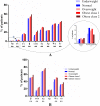BMI differences among in-hospital management and outcomes in patients with atrial fibrillation: findings from the Care for Cardiovascular Disease project in China
- PMID: 32503432
- PMCID: PMC7275422
- DOI: 10.1186/s12872-020-01544-8
BMI differences among in-hospital management and outcomes in patients with atrial fibrillation: findings from the Care for Cardiovascular Disease project in China
Abstract
Background: Underweight or obese status influences the prognosis of atrial fibrillation (AF). However, the association between stratification of body mass index (BMI) and in-hospital outcomes in patients with AF, remains lacking in China.
Methods: Using data from the Improving Care for Cardiovascular Disease in China-AF project, which was launched in February 2015 and recruited 150 hospitals in China, we compared characteristics, in-hospital treatments and clinical outcomes among the stratifications of BMI for Asians.
Results: A total of 15,867 AF patients with AF were enrolled, including 830 (5.23%) underweight, 4965 (31.29%) with normal weight, 3716 (23.42%) overweight, 5263 (33.17%) obese class I and 1093 (6.89%) obese class II participants. Compared with normal weight patients, underweight, overweight, and obese patients showed increased percentages of CHADS2 scores (3-6) and CHA2DS2-VASc scores (5-9). During hospitalization, overweight or obese patients showed greater use of rhythm control medications, anticoagulant drugs, and intervention therapies than underweight-normal weight patients. In adjusted logistic models, BMI was a strong predictor of in-hospital mortality. Especially, underweight BMI was associated with higher incidence of in-hospital mortality, with an adjusted odds ratio of 2.08 (95% confidence interval, 1.56-4.46; p = 0.04) than overweight and obese BMI.
Conclusions: Asian patients with AF and high BMI received more medical treatments and presented less adverse in-hospital outcomes compared with those with underweight-normal weight. Although low BMI may be associated with other comorbidities and advanced age, underweight BMI retained a negative correlation with all-cause mortality in the patients with AF during hospitalization.
Keywords: Atrial fibrillation; Body mass index; Clinical outcomes; Medical care.
Conflict of interest statement
As AHA sponsor to this multi-center project, Pfizer bears no responsibility on the goals, execution, nor publication of the project. The authors are solely responsible for the design and conduct of this content, all study analyses, the manuscript performance, and its final contents. The authors declare that they have no competing interests.
Figures



Similar articles
-
Body mass index and all-cause mortality in patients with atrial fibrillation: insights from the China atrial fibrillation registry study.Clin Res Cardiol. 2019 Dec;108(12):1371-1380. doi: 10.1007/s00392-019-01473-3. Epub 2019 Apr 5. Clin Res Cardiol. 2019. PMID: 30953181
-
Body mass index is associated with prognosis in Japanese elderly patients with atrial fibrillation: an observational study from the outpatient clinic.Heart Vessels. 2016 Sep;31(9):1553-61. doi: 10.1007/s00380-015-0765-y. Epub 2015 Oct 26. Heart Vessels. 2016. PMID: 26498940
-
Impact of body mass index on real-world outcomes of rivaroxaban treatment in Japanese patients with non-valvular atrial fibrillation.Heart Vessels. 2020 Aug;35(8):1125-1134. doi: 10.1007/s00380-020-01587-z. Epub 2020 Apr 6. Heart Vessels. 2020. PMID: 32253531 Free PMC article.
-
The impact of underweight and obesity on outcomes in anticoagulated patients with atrial fibrillation: A systematic review and meta-analysis on the obesity paradox.Clin Cardiol. 2021 May;44(5):599-608. doi: 10.1002/clc.23593. Epub 2021 Mar 26. Clin Cardiol. 2021. PMID: 33769583 Free PMC article.
-
The obesity paradox for outcomes in atrial fibrillation: Evidence from an exposure-effect analysis of prospective studies.Obes Rev. 2020 Mar;21(3):e12970. doi: 10.1111/obr.12970. Epub 2019 Dec 17. Obes Rev. 2020. PMID: 31849187 Review.
Cited by
-
Impact of body mass index on in-hospital mortality for six acute cardiovascular diseases in Japan.Sci Rep. 2022 Nov 7;12(1):18934. doi: 10.1038/s41598-022-23354-y. Sci Rep. 2022. PMID: 36344547 Free PMC article.
-
Prevalence and clinical predictors of inappropriate direct oral anticoagulant dosage in octagenarians with atrial fibrillation.Eur J Clin Pharmacol. 2022 May;78(5):879-886. doi: 10.1007/s00228-022-03286-2. Epub 2022 Feb 9. Eur J Clin Pharmacol. 2022. PMID: 35138442 Free PMC article.
References
-
- Kalra S, Kishor K, Batra A, Aggarwal S. Atrial fibillation in diabetes: need for cardiovigilance. J Pak Med Assoc. 2019;69:437–439. - PubMed
Publication types
MeSH terms
LinkOut - more resources
Full Text Sources
Medical

